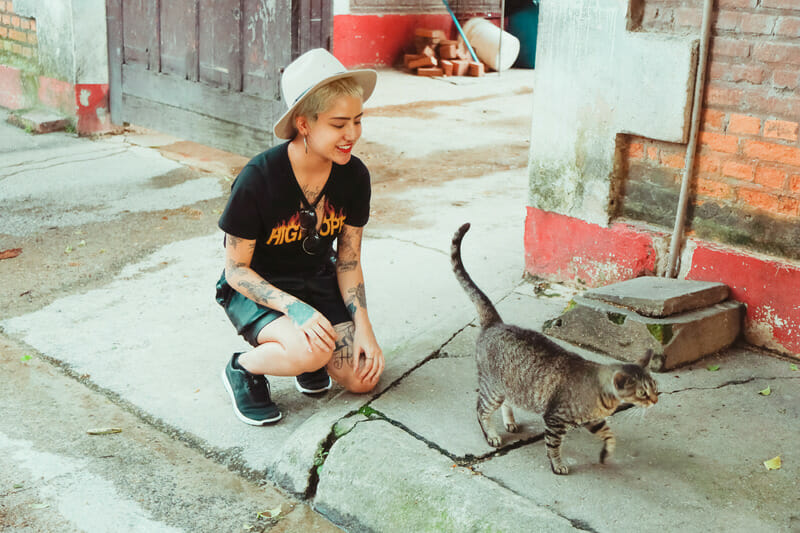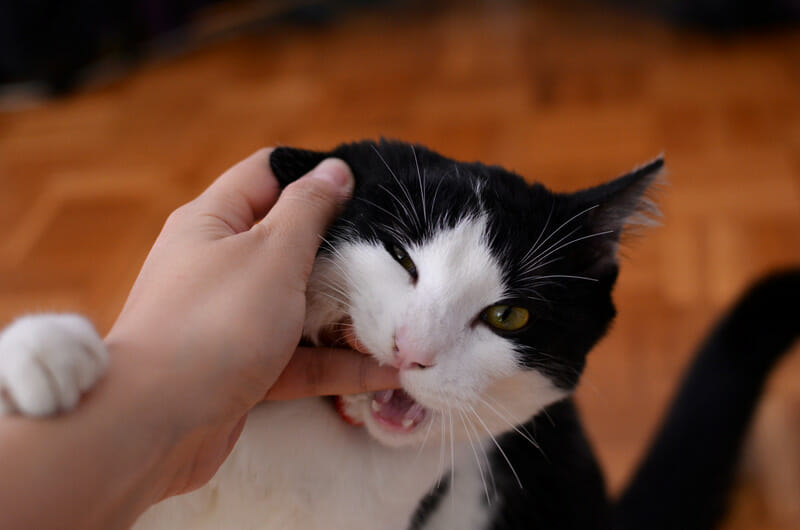Have you ever felt the urge to pet an unknown cat the moment you come across it? We’ve all been guilty of doing this without thinking of the possible repercussions, the worst of which could be the cat accidentally scratching or biting you. Though cats are social creatures, they don’t communicate and interact the same way we humans do. Through this guide, you’ll learn:
- The factors to consider when petting a cat
- How to successfully pet a cat
- The signs to look out for while petting a cat
- Other petting considerations
Factors to consider when petting a cat
Not all cats are the same. When dealing with a cat for the first (or even the nth) time, you should always assess: a) his personality, b) his mood, and c) your approach.
Cat personalities
Cats are behaviourally categorised as active, playful and aggressive, calm and sociable, or timid and shy. As kittens, they go through a socialisation period from 2 to 7 weeks of age. If they are properly exposed to people, other animals, and a variety of external stimuli during this time, they grow up to become more outgoing and less fearful. Those who have not been handled by humans during this period remain uneasy with human contact their entire lives, but that doesn’t mean they can’t be touched at all.
Cat moods
Another major factor is the kitty’s current disposition. You can’t force a cat to approach or respond to you when he’s not in the mood to socialise. Since cats are not obligate social creatures (versus humans who choose to display affection through touch and proximity), a cat may simply choose to ignore your advances. Dr. Michael Nappier from the Virginia-Maryland College of Veterinary Medicine’s Department of Small Animal Clinical Sciences explains, “Cats just don’t need social interaction to be content. We’re just perceiving it as a negative reaction because humans are obligate social animals.”
How you approach a cat
Aside from the cat’s personality and mood, how you approach it plays a big role in making this cat petting experience a success or failure. An article from The Conversation has revealed that a person’s gender and personality, how a person handles cats in general, and the parts of the cat’s body a person touches all determine how the cat will respond.

How to successfully pet a cat
Follow these step-by-step tips to pet a cat:
1 Observe the cat’s body language.
Start off by assessing the cat’s body language while letting it make the first move. If the cat approaches you, rubs up against you, or leans against you, it’s likely that it’s showing affection and wants to be petted.
2 Adjust to the cat’s level.
Crouch down or sit on the floor to appear less intimidating to the cat. Slowly offer your index finger so that the cat can get acquainted with your smell. Let her come into your space instead of encroaching her space. Never run after the cat or the action might traumatise her.
3 Stay calm.
Speak in a slow and relaxed manner. Avoid making abrupt movements or loud noises that might startle the cat.
4 Pet the cat in its safe areas.
Before petting the cat, ask the owner where the cat prefers to be touched. Safe areas generally include the face, the top of the head, between the ears, the back of the neck, under the chin, or the sides of the cheeks (but be careful of the cat’s whiskers). Refrain from touching a cat’s stomach, back, lower back, and tail.
5 Use the right level of touch.
Let your hand come in from the side instead of directly over a cat’s face so you don’t scare him off. Go for light, gentle motions unless you know he prefers heavy-handed strokes. Pet him following the direction of his fur.
6 Watch for changing signals.
A cat’s behaviour, reaction, and posture can suddenly change as he becomes overstimulated by your touch. Be mindful of his petting preferences and the subtle changes in his body to make it an enjoyable experience for the two of you.
Signs to observe while petting a cat
You can tell if the cat enjoys being touched or is on the verge of moving away through these telltale signs:
Signs the cat likes being petted
- Purrs
- Kneads using front paws
- Slow eye blinks
- Rubs on the person
- Licks the person or themselves
- Ears prick or point forward
- Holds tail up or waves it from side to side
- Gives you a gentle nudge if you stop petting
- Overall relaxed body posture
Signs the cat’s reaching its tolerance level
- Licking lips or nose
- Lowers head
- Ears flatten to the sides or rotate backwards
- Exaggerated blinks
- Skin ripples or twitches (usually along the back area)
- Meows or makes low growling sounds
- Tail lashes or thumps
- Body shifts or shakes
- Moves away from the person
- Attempts to bite or scratch the person

Other petting considerations
When petting other people’s cats, you should always err on the side of caution and ask their owners if they are open to being petted. Some cats can only handle limited physical contact, so it’s best to pet them for shorter periods of time and let them go before they reach their limit. A common behavioural issue in cats, petting-induced aggression can be avoided by figuring out the cat’s signs of irritation before it strikes, determining its threshold, and desensitising the cat in a gradual way.
If your cat suddenly dislikes being touched or becomes aggressive towards you, bring her to the veterinarian. Your cat may be experiencing fear, pain, or illness that you may not be aware of, such as arthritis, dental disease, thyroid disorder, urinary tract infection, skin conditions, or anal gland problems. Even past physical trauma or conflict with other housemates may trigger petting-induced aggression.
Always remember…
Though it’s tempting to show your affection to an adorable cat by petting it, you must accept the cat’s limits and acknowledge that it has a choice in the encounter. Build trust with the cat by letting it initiate the petting session, making the cat feel safe throughout the entire experience, and stopping the instant it displays any signs of annoyance.
Read more animal-related guides from Waldo’s Friends here. Learn why cats hiss or why they love to knead.
Leave a comment
Your email address will not be published. All fields are required.